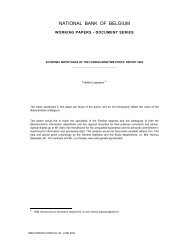A multi-factor model for the valuation and risk management of ...
A multi-factor model for the valuation and risk management of ...
A multi-factor model for the valuation and risk management of ...
Create successful ePaper yourself
Turn your PDF publications into a flip-book with our unique Google optimized e-Paper software.
Deposit balance dynamics In valuing deposit accounts, it is crucial to clearly de…ne <strong>the</strong> relevant<br />
<strong>and</strong> irrelevant deposit cash ‡ows (Barth (2005). Indeed, <strong>the</strong> <strong>valuation</strong> <strong>of</strong> current outst<strong>and</strong>ing<br />
deposits will di¤er signi…cantly from <strong>the</strong> <strong>valuation</strong> <strong>of</strong> current <strong>and</strong> future expected deposits. Moreover,<br />
future expected deposits refer to both new deposits <strong>of</strong> existing depositors as well as new<br />
deposits <strong>of</strong> new depositors. In our eyes, both existing deposits <strong>and</strong> future expected deposits need<br />
to be included, but <strong>the</strong> latter only to <strong>the</strong> extent that <strong>the</strong>y can be identi…ed in a veri…able way.<br />
For example, if a client can only take out a mortgage if he signs a contract that he promises that<br />
his salary will be cashed out on his deposit account, <strong>the</strong> bank should also include <strong>the</strong> expected<br />
future new deposits based on <strong>the</strong> monthly salary payments <strong>of</strong> its existing depositor. In contrast,<br />
<strong>the</strong> arrival <strong>of</strong> new depositors is not truly veri…able <strong>and</strong> hence should be excluded from <strong>the</strong> exercise<br />
to value deposits.<br />
Because <strong>of</strong> data limitations, we choose to per<strong>for</strong>m <strong>the</strong> <strong>valuation</strong> <strong>of</strong> existing deposits only. Our<br />
primary aim is thus to reliably estimate <strong>the</strong> economic value <strong>of</strong> <strong>the</strong> current volume <strong>of</strong> DDAs <strong>and</strong> its<br />
sensitivity to market interest rates, disregarding future new deposits. An important problem is that<br />
we can not assess <strong>the</strong> extent to which outst<strong>and</strong>ing deposits react to, say, opportunity cost changes<br />
by simply regressing our sample <strong>of</strong> deposit balances on <strong>the</strong> spread between market <strong>and</strong> deposit<br />
rates. The reason is that <strong>the</strong> observed ex post historical deposit dynamics involve a mixture <strong>of</strong><br />
both existing <strong>and</strong> newly-collected deposits <strong>and</strong> <strong>the</strong> latter need to be excluded from <strong>the</strong> regression<br />
analysis. In <strong>the</strong> absence <strong>of</strong> reliable data on outst<strong>and</strong>ing balance dynamics (which banks typically<br />
do have), we can not endogenize outst<strong>and</strong>ing deposit balance dynamics <strong>and</strong> rely upon a more ad<br />
hoc approach. Speci…cally we assume that (i) outst<strong>and</strong>ing deposit balances grow continuously (pro<br />
rata) at <strong>the</strong> deposit rate r d (t), i.e. we assume that people capitalize <strong>the</strong> deposit rent that is paid<br />
out to <strong>the</strong>m on <strong>the</strong>ir account, <strong>and</strong> that (ii) aggregate outst<strong>and</strong>ing deposit balances are withdrawn<br />
at a constant annualized withdrawal or decay rate r w , i.e.:<br />
dD (t) = r d (t) r w D (t) dt (22)<br />
O’Brien (2000) <strong>and</strong> Hutchison <strong>and</strong> Pennacchi (1996) report <strong>the</strong>ir main results under <strong>the</strong> assumption<br />
<strong>of</strong> constant deposit balances (i.e. zero decay rates, 100 percent retention rates, or in…nite halving<br />
times). We report results <strong>for</strong> a range <strong>of</strong> plausible, constant, annual decay rates <strong>and</strong> allow r w to<br />
vary between 10% <strong>and</strong> 50%. 8 We also present estimation results where we simply assume constant<br />
deposit balances.<br />
Note that <strong>the</strong> <strong>valuation</strong> <strong>of</strong> current <strong>and</strong> expected future deposits is a more challenging exercise 9 .<br />
First, <strong>the</strong> expected new deposits that we can measure in a veri…able way need to be estimated.<br />
Second, <strong>the</strong> <strong>valuation</strong> exercise may raise technical problems as nothing guarantees that discounted<br />
economic rents converge to zero over a …nite horizon when deposit balances are expected to grow.<br />
A convergence problem arises whenever veri…able deposit balance growth rates exceed <strong>the</strong> discount<br />
rate that applies in computing <strong>the</strong> present value <strong>of</strong> economic rents. Some bankers have reported<br />
that <strong>the</strong>y use cuto¤ horizons, say 10 year, after which earned economic rents are neglected. The<br />
cuto¤ horizon basically becomes ano<strong>the</strong>r <strong>model</strong> parameter. As mentioned above, we have opted<br />
not to present estimates <strong>for</strong> this kind <strong>of</strong> exercise, given a lack <strong>of</strong> data <strong>and</strong> <strong>the</strong> higher discretion<br />
<strong>and</strong> estimation uncertainty that it entails.<br />
to depend on market concentration. They …nd that deposit rates are on average higher in less concentrated markets,<br />
in line with expectations.<br />
8 Based on equation (22), we can compute outst<strong>and</strong>ing deposits halving times, s t (s > t), as a function <strong>of</strong> <strong>the</strong><br />
decay rate parameter. For an average deposit rate <strong>of</strong> 2:75%, it follows approximately that <strong>the</strong> halving time is 9:6<br />
year <strong>for</strong> a decay rate <strong>of</strong> 10% <strong>and</strong> only 1:5 year <strong>for</strong> a 50% decay rate.<br />
9 O’Brien (2000) reports <strong>and</strong> discusses convergence problems when extrapolating <strong>model</strong>-implied log deposit balance<br />
dynamics that are assumed to be a function <strong>of</strong> <strong>the</strong> spread between <strong>the</strong> short rate <strong>and</strong> <strong>the</strong> deposit rate, lagged<br />
log deposit balances, <strong>and</strong> a measure <strong>of</strong> income. O’Brien’s benchmark results based on constant deposit balances do<br />
not raise <strong>the</strong>se convergence complexities. Likewise, Hutchison <strong>and</strong> Pennacchi (1996) also report <strong>the</strong> bulk <strong>of</strong> <strong>the</strong>ir<br />
results under a zero deposit balance growth rate assumption.<br />
8
















